![]()
![]()
![]()
Use LEFT and RIGHT arrow keys to navigate between flashcards;
Use UP and DOWN arrow keys to flip the card;
H to show hint;
A reads text to speech;
45 Cards in this Set
- Front
- Back
|
Pathway of ingested food
|
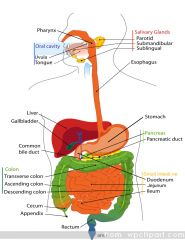
Mouth→pharynx→esophagus→stomach→small intestine (duodenum, jejunum, ileum)→large intestine→colon (ascending, transverse, descending, sigmoid)→rectum→anus
|
|
|
2 processes of digestive breakdown
|
1) Mechanical--teeth, tongue, stomach
2) Chemical-almost everywhere |
|
|
2 digestive properties of mouth
|
1) Salivary α-amylase breaks down starch→maltose (disaccharide)
2) Mechanical breakdown and formation of BOLUS |
|
|
Pharynx
|
Location of the epiglottis which directs bolus down esophagus away from the trachea
|
|
|
Esophagus
|
-serves as conduit for bolus, contracting smooth muscle through peristalsis action
-no enzymatic function |
|
|
What is the common reaction in digestion of macromolecules?
|
Hydrolysis
|
|
|
Bile function
|
-Complex non-enzymatic alkaline mixture of substances that emulsify large clumps of fat→small fat molecules to ↑ SA for lipase action
-Produced in liver→cystic duct→gallbladder→ common bile duct→pancreatic duct→duodenum |
|
|
Bile is produced and stored in the gallbladder (T/F)
|
False. It is produced in the liver and stored in the gallbladder.
-Produced in liver→cystic duct→gallbladder→ common bile duct→pancreatic duct→duodenum |
|
|
What separates the esophagus and stomach?
|
Cardiac sphincter or lower esophageal sphincter
|
|
|
Stomach function
|
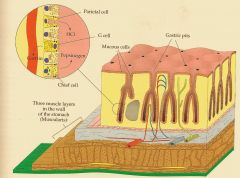
-flexible pouch that mixes and stores food→chyme
-low pH (~2) → denatures proteins & kills bacteria |
|
|
What are the 4 major cell types of the stomach?
|
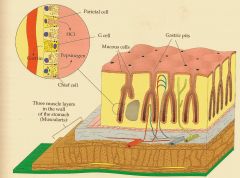
1) mucous cells: secrete mucous; lubrication+damage control
2) chief (peptic) cells: found in deep exocrine glands; secrete pepsinogen→pepsin in stomach 3) parietal (oxyntic) cells: secrete HCl, use lots of mitochondria for manufacture. H+ into lumen and bicarbonate into blood (↓ lumen pH, ↑ blood pH). Also secretes intrinsic factor→helps ileum absorb B12 4) G cells: secretes gastrin into interstitium→ absorbed in blood→stimulates parietal cells to secrete HCl |
|
|
What 3 hormones affect secretion of stomach juices?
|
-acetylcholine: all cell types
-gastrin: parietal cells→HCl -Histamin: parietal cells→HCl |
|
|
Pepsin
|
Digests proteins→polypeptides
|
|
|
90% of digestion and absorption takes place in the ___?
|
Small intestine
-duodenum→ digestion -jejunum and ileum→ absorption |
|
|
What is villi and what does each contain?
|
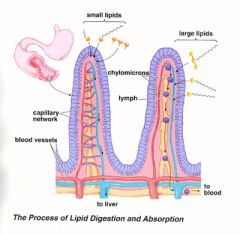
-villi ↑ SA of intestinal wall allowing for greater digestion and absorption
-each contains microvilli, enterocytes (apical side), capillary network and a lacteal (lymph vessel) |
|
|
The brush border contains numerous enzymes (T/F)
|
True.
Some include: dextrinase, maltase, sucrase, lactase, peptidases, nucleosidases |
|
|
Goblet Cells
|
Secrete mucous in the intestine
-helps protect brush border from mechanical/chemical damage |
|
|
Crypts of Lieberkuhn
|
-intestinal exocrine glads located deep btwn each villi
-secretes: -intestinal juice pH 7.6 -lysozyme→regulate bacteria -enteropeptidase |
|
|
What separates the stomach and small intestine?
|
Pyloric sphincter
|
|
|
The pH of the small intestine is mostly due to what ion?
|
Bicarbonate secreted by pancreas
-buffers intestine at a pH ~6 |
|
|
Enteropeptidase or Enterokinase
|
-activates zymogen trypsinogen→trypsin
-secreted by the crypts of Lieberkuhn |
|
|
Major protein enzymes
|
-trypsin
-chymotrypsin -carboxypolypeptidase (cleaves aa sides) |
|
|
Major carbohydrate enzymes
|
-salivary amylase: degrades starch into small polypeptides
-pancreatic amylase: more powerful enzyme that hydrolyzes polysaccharides→di/trisaccharides -Others: dextrinase, maltase, sucrase, lactase |
|
|
Major nucleotide enzymes
|
-ribonuclease
-deoxynuclease |
|
|
Lipase
|
Degrades fats, specifically TRIGLYCERIDES
|
|
|
Major functions of large intestine
|
-water resorption
-electrolyte resorption -symbiosis with bacteria for bacteria production |
|
|
What 4 vitamins do E. Coli produce in the large intestine?
|
-Vitamin K
-B12 -Thiamin -Riboflavin |
|
|
Gastrointestinal local peptide hormones: Name and function.
|
Secretin- Stimulates pancreatic NaHCO3 secretion. Activated by HCl in duodenum
Cholecytokinin- Causes gallbladder contraction and pancreatic enzyme secretion. Stimulated by food (fats) Gastric Inhibitory peptide- decreases motor activity of stomach. Stimulated by fats/proteins (some carbs) in duodenum. |
|
|
Common main function of gastrointestinal local peptide hormones. When is it released?
|
-Regulates process of stomach releasing small amounts of food at a time for maximum absorption
-Released after a meal. INCREASES BLOOD INSULIN. |
|
|
Major carbohydrates consumed in human diet
|
-starch: straight chain of glucose
-lactose: disaccharide of glucose+galactose -sucrose: disaccharide of glucose+fructose |
|
|
Carbohydrate absorption of glucose, galactose, and fructose
|
![Glucose: Active transport into enterocyte down Na+ gradient (glucose binds protein first). Under high [glucose], diffuses through tight junctions to basolateral side
Galactose: similar to glucose
Fructose: absorbed via facilitated diffusion. Most fr](https://images.cram.com/images/upload-flashcards/915892/617727_m.jpg)
Glucose: Active transport into enterocyte down Na+ gradient (glucose binds protein first). Under high [glucose], diffuses through tight junctions to basolateral side
Galactose: similar to glucose Fructose: absorbed via facilitated diffusion. Most fructose→glucose inside enterocyte |
|
|
What happens to digested carbs after absorption into enterocytes?
|
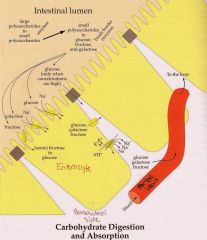
Facilitated diffuse through enterocyte into portal vein to the liver:
-converted to glucose, glycogen, or fatty acids & triglycerides if saturation point of glycogen is reach |
|
|
All cells absorbed glucose via facilitative diffusion (T/F)
|
False. ALMOST ALL except:
-apical surface of enterocytes -cells of the renal tubule |
|
|
How does enterocyte keep Na+ levels low for active transport of glucose into cell?
|
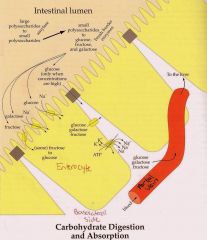
-Na+/K+ pump: pumps Na+ out on basolateral surface
|
|
|
Where are polypeptides first digested?
|
In the stomach by pepsin
|
|
|
Absorption of digested proteins occurs via ___? (2)
|

-cotransport down Na+ gradient in entercytes (similar to glucose)
-some aa are transported via facilitated diffusion |
|
|
Once broken down into amino acids in enterocytes and absorbed into blood via portal vein, amino acids may be transported into cells by facilitated, active, or passive means. (T/F)
|
![False.
-Too LARGE and POLAR to passively diffuse
-Cells quickly turn aa→proteins to lower cellular [aa]](https://images.cram.com/images/upload-flashcards/915892/617731_m.jpg)
False.
-Too LARGE and POLAR to passively diffuse -Cells quickly turn aa→proteins to lower cellular [aa] |
|
|
Virtually all polypeptides are broken down into amino acids before absorbed into blood. (T/F)
|
True.
-protein that is not broken down may cause allergic rxns |
|
|
Energy burned measured in cal/g of: protein, fat, and carbohydrate
|
Protein: 4 cal/g
Fat: 9 cal/g Carbohydrates: 4.5 cal/g |
|
|
Micelle significance in small intestine
|
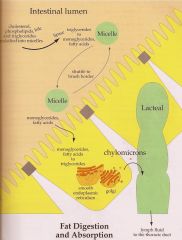
-Shuttles monoglycerides & FA from intestinal lumen→brush border
-responsible for the absorption of complicated lipids (e.g, lecithin, hyrdrolyzed cholesterol/phospholipids) and lipid soluble vitamins (A, D, E and K) |
|
|
Albumin
|
"molecular taxi"
-Free fatty acids (3-30) are transported in the blood bound to albumin, a serum protein secreted by the liver |
|
|
Apoproteins
|
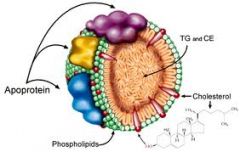
Bind lipids to make up LIPOPROTEINS
|
|
|
Lipoproteins & chylomicron
|
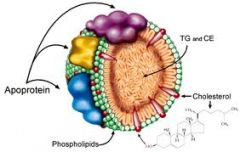
-Differ in ratio of protein to lipids, and in the particular apoproteins and lipids that they contain. -They are classified based on their density:
-chylomicron (largest; lowest in density due to high lipid/protein ratio; highest in triacylglycerols as % of weight) -VLDL (very low density lipoprotein; 2nd highest in triacylglycerols as % of weight) -IDL (intermediate density lipoprotein) -LDL (low density lipoprotein, highest in cholesteryl esters as % of weight) -HDL (high density lipoprotein, highest in density due to high protein/lipid ratio). |
|
|
Pathway of digested lipid absorption
|
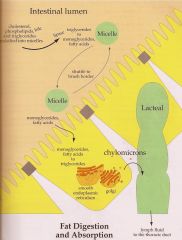
Fats + bile→emulsified fats + lipase→MGs, FAs packaged & shuttled by micelle to brush border→diffuse through enterocyte membrane→MGs, FA's converted back to TGs at SER→FA's, cholesterol, etc orient into micelle in lumen & transported by apoprotein to golgi→exocytosis of "chylomicrons" into lacteal lymph system→thoracic duct→ liver and adipose tissue
|
|
|
All fatty acids are are directed to the lymph system
|

False.
-small amounts of more water soluble (short chain) FAs are absorbed directly into blood of villi |

